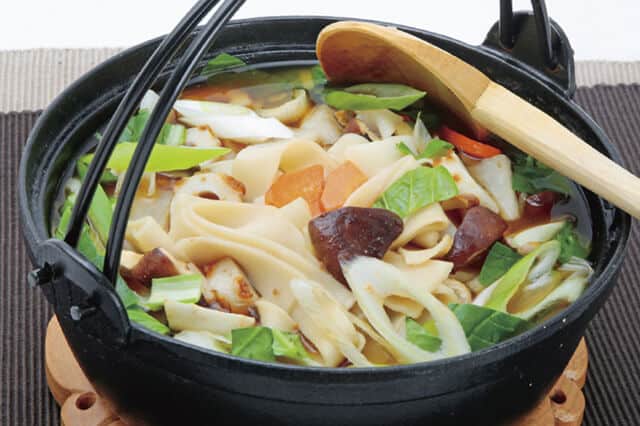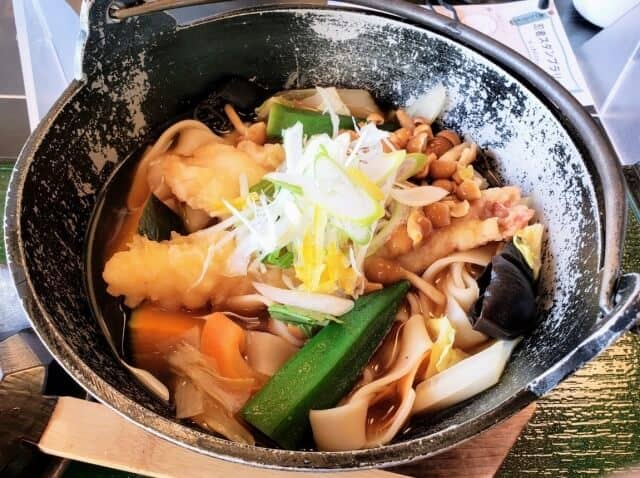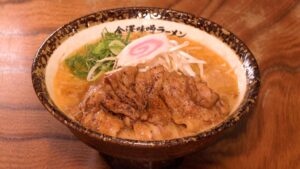Have you ever heard the word “okkirikomi”? Okkirikomi is a local dish of Gunma Prefecture. This time, we will introduce the characteristics and history of Okkirikomi’s cuisine, and the origin of its name. Also, for those who want to try Okkirikomi, we will also introduce how to make it and where to buy it, so please check it out!
What is Okkirikomi?
Okkirikomi (おっきりこみ) is a traditional Japanese dish from Gunma Prefecture and northern Saitama Prefecture. It is one of the “100 Local Dishes of Rural Fishing Villages,” according to the Ministry of Agriculture, Forestry, and Fisheries. Although there are some regional variations, the noodles are generally made of wheat flour and are cooked raw with veggies and other things. Soups made with miso or soy sauce are popular, and root vegetables are part of the ingredients. Hand-kneaded flat, wide udon noodles and seasonal vegetables like taro and daikon radish are what locals cook in broth seasoned with soy sauce or miso in okkirikomi. It’s also known as Nibo-to, Nibo-tou, or Okirikomi in some regions.
Etymology

The reason why the noodle dish “Okkiri Komi” is so-called is in how it is made. “Okkirikomi (おっきりこみ)” can be written in Chinese characters as “Okkirikomi (お切り込み). This characters “切り込み” means “cutting in and putting in”, noodles, and quickly cutting in the noodles while boiling vegetables and other ingredients and putting them in a pot. In the past, every family had a fireplace, where they put a lot of vegetables in a pot and put noodles in it while cooking it.
Okkirikomi History

“Okkirikomi” is said to have spread the food that Yoshishige Nitta had eaten in the Imperial Court from China in the 12th century at the end of the Heian period to the present-day Gunma prefecture in Ueno. Yoshishige Nitta is a grandson of the Genji family and also known as Genji Yoshishige, the founder of the Nitta clan, a powerful family based in the city of Ueno.
Yoshishige was responsible for arranging and preparing meals for ingredients called “Oinosuke” in the Imperial Court at that time, and it is said that he came into contact with a dish called “buto” introduced from China at that time, which later spread as “hoto” in Japan. The manufacturing method was brought back to Joshu, the country of Ueno, and spread as “Okkirikomi”, which they call it “Joshu Hoto”.
Okkirikomi Recipe

Okkirikomi Ingredients
| Ingredients of Okkirikomi for 4 person | |
| [Noodles] Medium-strength flour | 300g |
| [Noodles] Water | 150g |
| [Noodles] Flour | 30g |
| Burdock | 60g |
| [Soup] Carrot | 60g |
| [Soup] Radish | 100g |
| [Soup] Taro | 150g |
| [Soup] Shiitake mushrooms | 80g |
| [Soup] Fried tofu | 40g |
| Green onions | 40g |
| Water | 2000g |
| Niboshi | 40g |
| Kelp (10cm square) | 30g |
| Katsuobushi | 10g |
| Soy sauce | 28g |
| Miso | 40g |
How to make Okkirikomi
Put medium-strength flour in a bowl, dent the center, and add water little by little. Knead well by hand until it is no longer powdery.
Roll the dough into a large plastic bag and step on it with your heels. Fold the dough and step further. Repeat several times until it is a little hard. Then, leave it in the bag and let it sit at room temperature for 20 to 30 minutes.
Place the dough and wrap it around a rolling pin. Trace the top of the rolling pin with a kitchen knife to cut it open, and then cut it to a width thicker than the udon noodles.
Put the water and kelp, dried sardines and dried bonito flakes with the head and cotton in a pan, soak for about 5 minutes, and then put on low heat.
When it boils, pull out the kelp, simmer the others on low heat for about 5 minutes, and then rub with a colander.
Cut carrots and radishes into ginkgo, taro into bite-sized pieces, shiitake mushrooms into slices, and green onions into round slices. Then, cut the burdock into round slices or diagonal slices. Lastly, cut the fried tofu into strips with a width of 7 mm.
Put the soup stock in a pan, add vegetables other than noodles and green onions from the ones that are difficult to boil, and heat on medium heat for 10 to 15 minutes. Add noodles, simmer, add green onions, and season with soy sauce and miso.
What are the differences between Okkirikomi and Houtou?

Many people confuse okkirikomi for Yamanashi Prefecture’s houtou, but the main ingredients are vastly different. Okkirikomi noodles are broad, flat udon noodles served in a soup with a lot of vegetables and a soy sauce base. The taro and the flour from the noodles combine to thicken the broth. While hōtō features wide and thin udon noodles boiled in a miso-based soup with pumpkins, Negi, shiitake mushrooms, and potatoes.
Differences between regions
Taste and ingredients
Hokumo and Nishige frequently use miso, but Tomo does use soy sauce, and both use it in Chumo. Tomo produces a lot of soy sauce, and there were few occasions to consume okkirikomi, thus it has a history of being consumed even when soy sauce was expensive. Miso was formerly the standard, but as soy sauce grew more popular in everyday life, soy sauce-based products began to spread from Tomo.
Locals can add potatoes to the ingredients, however, they commonly used taro at the foot of Mt. Akagi and Mt. Haruna. While potatoes are common in the Agatsuma-gun and Tano-gun mountains. Sweet potatoes and pumpkins, on the other hand, are uncommon.
Naming of the dish
The name “okkirikomi” is widely used in Gunma prefecture. This name is derived from the cooking method of “cutting” the kneaded dough directly from the top of the spatula into the pot. In Hokumo, it is called “hoto”, and in Tomo, it is called “nibot” or “nibot”. Even in the northern part of Saitama prefecture, there is an area called “Niboto”.
The types of soup in Gunma prefecture

In Gunma prefecture, they have different types of seasoning in their soups. In the Northern part, they have their soup in a miso flavor while in the Eastern and Middle part, they have their soup in the flavor of soy sauce. On the other hand, the Western part is distinct of all, it has a Shinto style with both miso and soy sauce flavors.
Okkirikomi vs udon

The difference from udon is that locals do not add salt to the noodles and that they do not boil the noodles before being put in the soup. Also, since the noodles are boiled as they are, the flour melts and the soup becomes thick. In the past, there was a difference in the quality of wheat flour, and some of the okkirikomi contained bran. This is because there was a distinction that okkirikomi is a home-cooked dish that locals ate daily, while udon is a “Halle” meal.
Where to buy Okkirikomi
Komi no Furusato (おっきりこみのふる里)

It is a long-established store that has been operating as a specialty store for okkirikomi since its establishment in 1968. The shop owner uses a whopping 20 kinds of colorful ingredients that are of the seasons. And they simmer the noodles firmly in the juice made from Joshu miso, so there is no hardness and many men and women of all ages preferred its texture.
Hayami (はや味)

The owner of Hayami has also trained at a restaurant, so you can enjoy the taste that is particular about the deliciousness of the soup stock. It is based on soy sauce and characterized by its light but tasty soup. The chewy noodles and the richly simmered okkirikomi are gems with many fans both inside and outside the prefecture.
Joshu Country House (上州 田舎屋)

It is a restaurant that offers a variety of dishes, centered on the local cuisine of Gunma prefecture. They served their okkirikomi in an iron pot and the synergistic effect of thick soup and iron makes it difficult to cool. But you can eat warm until the end. The soy sauce-flavored soy sauce is especially popular for people who like a light taste.
Nosho Nitta (新田乃庄 本店)

Here, the dish the shop owner serve is under the name of “Kirihoto”, which is a combination of both okkirikomi and boiled hoto. They made the soup stock from simmered noodles with ingredients such as vegetables from Gunma. In addition to the orthodox soy sauce base and miso base, there are also curry-flavored okkirikomi. In the summer, cold refreshing drinks are also up for a limited time.
Final thoughts

Okkirikomi is a warm Japanese meal consisting of large fresh noodles simmered in soy sauce or miso-based soup. It’s also known as boiled sardines in some parts of Gunma. It has the advantage of including seasonal foods such as veggies and mushrooms as well as being healthful. As a result, it was originally considered one of Gunma’s traditional winter dishes. Now, it is a regional specialty that locals and tourists can enjoy all year.
If you are into Gunma’s specialty dish, you can also try out their Yaki Mochi and Himakawa Udon.
















Comments